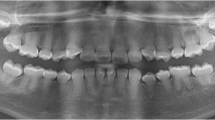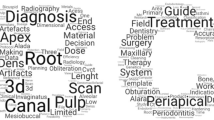Abstract
In this case report, we present the endodontic treatment and microsurgical intervention of dens invaginatus affecting a lateral incisor using cone-beam-computed tomography (CBCT). A 26-year-old woman visited us with a diagnosis of acute apical periodontitis in the upper right lateral incisor (tooth 12). Endodontic treatment of the tooth was carried out. Intraoral radiography provided limited information on the unusual anatomy of the pulp chamber and root canal system; therefore, preoperative CBCT was performed. At the 3-month recall, a radiograph revealed a 5-mm-diameter lateral transparency, and CBCT was, therefore, repeated to facilitate microsurgery treatment planning. A medical image-processing program was used to demonstrate the changes between the CBCT images obtained before and after root canal preparation. In conclusion, endodontic treatment of dens invaginatus is challenging even for endodontic specialists, because the therapy sometimes requires surgical intervention. The currently available novel three-dimensional imaging modalities may have importance in planning and following up the root canal treatment in such cases, especially when unforeseen complications arise.








Similar content being viewed by others
References
Backman B, Wahlin YB. Variations in number and morphology of permanent teeth in 7-year-old Swedish children. Int J Pediatr Dent. 2001;11:11–7.
Hulsmann M. Dens invaginatus: aetiology, classification, prevalence, diagnosis, and treatment considerations. Int Endod J. 1997;30:79–90.
Oehlers F. Dens invaginatus. I. Variations of the invagination process and associated anterior crown forms. Oral Surg Oral Med Oral Pathol. 1957;10:1204–18.
Omnell K, Swanbeck G, Lindahl B. Dens invaginatus. II. A microradiographical, histological and micro X-ray diffraction study. Acta Odontol Scand. 1960;18:303–30.
Beynon A. Developing dens invaginatus (dens in dente). A quantitative microradiographic study and a reconsideration of the histogenesis of this condition. Br Dent J. 1982;153:255–60.
De Smit A, Jansen H, Dermaut L. An histological investigation of invaginated human incisors. J Biol Buccale. 1984;12:201–9.
Rotstein I, Stabholz A, Heling I, Friedman S. Clinical considerations in the treatment of dens invaginatus. Endod Dent Traumatol. 1987;3:249–54.
Hommez GMG, De Moor RJG, Braem M. Endodontic treatment performed by Flemish dentists. Part 2. Canal filling and decision making for referrals and treatment of apical periodontitis. Int Endod J. 2003;36:344–51.
Hallet G. The incidence, nature, and clinical significance of palatal invagination in the maxillary incisor teeth. Proc R Soc Med. 1953;46:491–9.
De-Deus G, Brandao MC, Fidel RAS, Fidel SR. The sealing ability of GuttaFlow in oval-shaped canals: an ex vivo study using a polymicrobial leakage model. Int Endod J. 2007;40:794–9.
Kovacs M, Fejérdy P, Dobo-Nagy C. Metal artefact on head and neck cone-beam CT images (Hungarian). Fogorv Sz. 2008;101:171–8.
Woods RP. AIR (automated image registration) (online). 2014. http://bishopw.loni.ucla.edu/air5/. Accessed 19 Aug 2016.
Woods RP, Mazziotta JC, Cherry SR. MRI-PET registration with automated algorithm. J Comput Assist Tomogr. 1993;17:536–46.
Woods RP, Grafton ST, Holmes CJ, Cherry SR, Mazziotta JC. Automated image registration: I. General methods and intrasubject, intramodality validation. J Comput Assist Tomogr. 1998;22:139–52.
Tsukada G, Tanaka T, Torii M, Inoue K. Shear modulus and thermal properties of gutta percha for root canal filling. J Oral Rehab. 2004;31:1139–44.
Meyer KM, Kollmar F, Schirrmeister JF, Schneider F, Hellwig E. Analysis of shrinkage of different gutta-percha types using optical measurement methods. Schweiz Mon Schr Zahnmed. 2006;116:356–61.
Patel S, Brandy E, Wilson R, Brown J, Manocci F. The detection of vertical root fractures in root filled teeth with periapical radiographs and CBCT scans. Int Endod J. 2013;46:1140–52.
Jae HP, Kiyoshi T, Payam O. 3-Dimensional cone-beam computed tomography superimposition: a review. Semin Orthod. 2015;21:263–73.
Peters OA, Peters CI, Schöneberger K, Barbakow F. ProTaper rotary root canal preparation: effects of canal anatomy on final shape analysed by micro CT. Int Endod J. 2003;36:86–92.
Bergmans L, Van Cleynenbreugel J, Wevers M, Lambrechts P. A methodology for quantitative evaluation of root canal instrumentation using microcomputed tomography. Int Endod J. 2001;34:390–8.
Szabo BT, Pataky L, Mikusi R, Fejerdy P, Dobo-Nagy C. Comparative evaluation of cone beam CT equipment with micro-CT in the visualization of the root canal system. Ann I Super Sanita. 2012;48:49–52.
Author information
Authors and Affiliations
Corresponding author
Ethics declarations
Conflict of interest
Karoly Mensch, Laszlo Simonffy, Csaba Dombi, Bence Tamas Szabó, Jozsef Varga, Alexander Juhasz, and Csaba Dobo-Nagy declare that they have no conflict of interest.
Human rights statement and informed consent
All procedures followed were in accordance with the ethical standards of the responsible committee on human experimentation (institutional and national) and with the Helsinki Declaration of 1964 and later versions. Informed consent was obtained from all patients for being included in the study.
Animal rights statement
This article does not contain any studies with animal subjects performed by any of the authors.
Rights and permissions
About this article
Cite this article
Mensch, K., Simonffy, L., Dombi, C. et al. Endodontic and microsurgical treatments of maxillary lateral incisor dens invaginatus in combination with cone-beam-computed tomography fusion imaging. Oral Radiol 33, 147–152 (2017). https://doi.org/10.1007/s11282-016-0257-5
Received:
Accepted:
Published:
Issue Date:
DOI: https://doi.org/10.1007/s11282-016-0257-5




